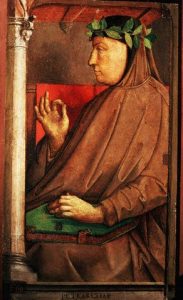Appel à communication : « Petrarch and Portraiture, XIV–XVI Century » (University of Cambridge, 8 juin 2018)
The aim of the conference is to investigate the interplay between Petrarch‘s writings and later Petrarchan literature with portraiture. Through his works in both Latin and in vernacular Petrarch made crucial contributions to the establishment of new models for representation and self-representation, both in literature and in the visual arts. Portraiture – the visual celebration of the individual – offers a particularly appropriate vantage point from which to investigate this influence.
Throughout Petrarch‘s extensive corpus, the reader engages with diverse types of portraits. In De viris illustribus, for instance, Petrarch presents literary depictions of many of the most important scriptural and classical personalities. The text inspired the tradition of portraits of famous men and women depicted as examples of conduct in private homes and studioli, a tradition that culminated in Paolo Giovio’s Musaeo of portraits on Lake Como. In the Letters and the Canzoniere, Petrarch fashions a literary portrait of his poetic alter-ego. His engagement with portraiture culminates in Rvf 77 and 78, which are dedicated to a portrait of Laura painted by Simone Martini. By weaving together the notions of literary and visual portraiture, the poet touches on issues such as the dialogue with the effigy of the beloved, the perceived conflict between the soul and the veil of appearances, and the dynamic relationship between word and image.
These aspects of Petrarch‘s work influenced subsequent reflections on the limits of art and literature in representing the complex nature of the individual. Literary texts dedicated to portraits became an extremely popular genre during the Renaissance, and contributed to the debate on ut pictura poesis. Significant examples are found in the poetry of Gaspara Stampa, Pietro Bembo, and Giovanni della Casa. If, as John Pope-Hennessy wrote, the modern portrait ‘reflects the reawakening interest in human motives and the human character, the resurgent recognition of those factors which make human beings individual’, Petrarch‘s intellectual legacy becomes a central reference for scholars.
The conference welcomes proposals exploring the dialogue and reciprocal influence between portraiture in all media (painting, sculpture, prints, medals, tapestry, jewellery, manuscripts, etc.) and Petrarch‘s production as well as that of his imitators. Although the conference will focus principally on the European context, proposals concerning relevant non-European case-studies will be equally welcome.
Papers should be presented in English and will last 20 minutes, followed by 10 minutes of questions. To apply please send a title, short abstract (no more than 300 words), and a short CV (no more than 2 pages) to Ilaria Bernocchi ib364@cam.ac.uk and Nicolò Morelli nm505@cam.ac.uk by 31 January 2018. The conference is kindly supported by the Department of Italian, University of Cambridge, through ‘The Italianist’ fund, and by Pembroke College, Cambridge.
Confirmed Keynote Speaker: Dr Federica Pich, University of Leeds
Confirmed Respondent: Dr Abigail Brundin, University of Cambridge


Leave a Reply
You must be logged in to post a comment.